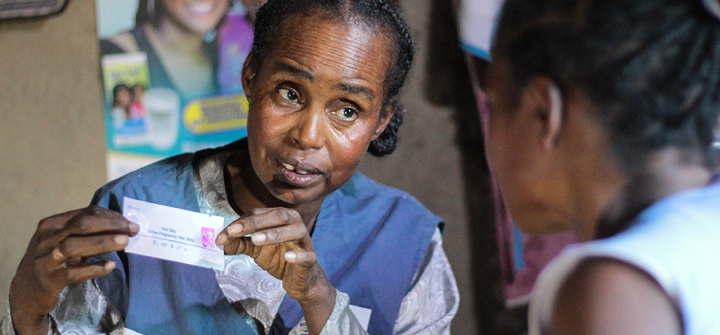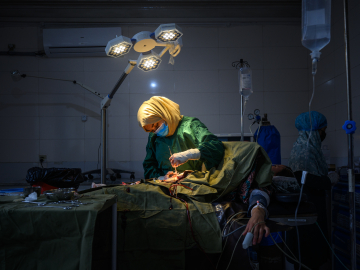Community Health Workers: A Priority for Universal Health Coverage?
How countries can move toward building sustainable community health programs
Universal health coverage (UHC) is increasingly recognized as the best way to achieve the Sustainable Development Goal targets on health. But with 400 million people lacking access to essential health services and a projected shortage of 18 million health workers, it will take unprecedented effort and funding. Community health workers (CHWs) could be an important part of the solution—but without effective investments and sound planning, we will fall short of achieving UHC.
Many low- and middle-income countries rely on a robust community health workforce, but few are self-sustaining and many rely heavily on external donors. CHWs fill critical gaps while delivering quality, affordable services closer to underserved patients. Even during crises, such as West Africa’s Ebola outbreak, CHWs can ensure the continuity of services while helping to stop epidemics.
As a 2015 report shows, CHWs can also yield a sound 10-to-1 return on investment, when accounting for a healthier population’s increased productivity and formal employment and the prevention of costly health crises. Expanding access to community services could prevent up to 3 million deaths annually while substantially reducing patients’ out-of-pocket costs.
Recognizing these benefits, low- and high-income countries alike are developing and expanding CHW programs. In Ethiopia, Community Health Extension Workers (CHEWs) proved instrumental in reducing maternal and child deaths and in meeting nearly all of the country’s 2015 Millennium Development Goals on health. Countries including Ghana and Sierra Leone are training and deploying a combined 35,000 CHWs to bridge gaps. Even in American cities like Philadelphia, CHWs are delivering evidence-based health interventions to high-risk patients while reducing overall health care costs.
While CHWs are not a new concept, the recent momentum for scaling CHWs raises an important question: will they be a long-term investment or simply a palliative solution to achieve short-term results?
Amid competing funding priorities and uncertainty around foreign assistance, countries show reluctance to invest in community health systems. CHWs are often unpaid volunteers, lack a career path, and are rarely considered part of the formal health workforce. These factors, combined with growing demand for their time, contribute to high rates of attrition. Further, in the absence of proper planning, frequently there is no funding for ongoing training, program support, and supervision of CHWs. This can lead to low-quality services or, worse, a complete stoppage of services in the most challenged communities.
To achieve UHC and the health SDG targets, long-term community health planning is essential—and along with helping countries identify solutions to meet health goals, it provides an opportunity to evaluate progress and make improvements. Planning can also help countries identify the costs and resource needs to sustain CHWs, including medicines and supplies; equipment; incentives; training; as well as program management, supervision, and reporting. It also cuts down on duplicative efforts among partners.
To facilitate this process, the NGO where I work, Management Sciences for Health, partnered with UNICEF to create a Community Health Planning and Costing Tool that helps calculate the costs of delivering comprehensive community health services for up to 10 years. To-date, the tool has helped plan the long-term implementation of national community health programs in Madagascar, Malawi, and Sierra Leone.
Understanding the costs and required financing for large-scale community health programs helps governments more effectively advocate for domestic and external funding sources, including the private sector. Plus, identifying funding gaps can help countries pool different sources to ensure that health programs operate fully and consistently.
As countries move toward building and sustaining national community health programs, they should consider a few key takeaways.
First, long-term financing plans should be developed to support continuous services and funding for all elements of a community health program. While domestically-financed programs may prove unrealistic for many countries, there are opportunities to leverage existing initiatives and donor funding. For example, in Rwanda, CHWs are integrated into the country’s national performance-based financing scheme, which provides incentives to fund income-generating activities. Other countries leveraged multi-year Global Fund support to cover antimalarial medicines, rapid diagnostic tests, training, and incentives.
Community health program funding should work to strengthen health systems overall. Embedded in weak health systems, CHWs programs will be ineffective and investments will fall flat. CHWs will only succeed when all building blocks are performing. For example, programs must reinforce strong supply chains, a dynamic supervisory and management workforce, and an effective flow of health information.
As frontline health workers, the CHW role should also be institutionalized in national health systems. Along with clearly defined responsibilities, they should receive ample recognition, incentives, and professional development opportunities. By doing so, countries can improve the quality of service delivery, ensure greater accountability to their communities, and increase CHW retention.
Lastly, we must continue to demonstrate the impact of CHWs and draw lessons. To strengthen the investment case for CHWs, we must go beyond demonstrating achievements of process indicators and coverage metrics and document how effectively CHWs improve patient outcomes, reduce costs to health systems and patients, and contribute to health milestones and targets. By sharing experiences and lessons-learned, other countries might avoid shortcomings and adapt program successes to address their health priorities.
Colin Gilmartin is a senior technical officer at Management Sciences for Health, a nonprofit global health organization. He specializes in health care financing and the planning and costing of community-based services. He can be followed on Twitter, @colingilmartin.
Join the thousands of subscribers who rely on Global Health NOW summaries and exclusive articles for the latest public health news. Sign up for our free weekday enewsletter, and please share the link with friends and colleagues: http://www.globalhealthnow.org/subscribe.html
Community Health Volunteer in a remote village of Tulear, Madagascar, giving instructions to a client on the use of pregnancy tests. Image by Samy Rakotoniaina/MSH




